Pen tablets
Sketch, draw and edit images with a responsive pad, a precise pen and see your creations appear on screen.

Welcome to the next installment of this tutorial series where we assemble a drawing of a face piece by piece. Hopefully you’ve been getting lots of tips and tricks to help you design characters or draw portraits and caricatures. Today we're going to talk about the nose.
In this tutorial you will learn step by step how to draw a nose.


When it comes to drawing the nose, the most difficult aspect is probably the simple fact that it protrudes three dimensionally from the face. In order to simplify this aspect, let's first reduce the nose to a geometric shape like the one here in the picture. It is a pyramid with an elongated top half. This shape will enable us to draw the nose from any angle we want.
With a little practice, you may not even need the pyramid to draw a nose in most cases. But, sometimes you might want to draw a face from a rather unusual angle. In these situations, it can be difficult to figure out how the nose should look. The pyramid is going to help you with that.
In order to ensure that the pyramid is properly formed, we start with a cross at the base, and draw the height from its center (dotted line in the picture). This will give us all the vertices, including the top. All we have to do is connect them.

As you can see, the different angles cause the pyramid to take very different shapes. If you are pretty confident, you can also try drawing the pyramid free-hand. But it tends to be safer to start with the cross at the base.
From here on, the base is the human head.

If you want to learn how to draw a nose, it's best to start with the face front on. Here I’ll be using the headshapes from the previous tutorials, of course.

(1) First of all, we’ll need that same triangle between the eyes that we learned about in the How to Draw Eyes tutorial. This triangle marks the area between the eyebrows and the nose bone.
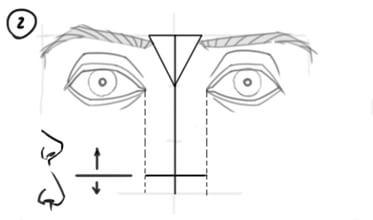
(2) Next, we draw the cross of our pyramid. At this point we can already determine how wide our nose is going to be. The average nose is about as wide as the distance between the eyes. So I will keep this width for this nose.
The crossbar also defines whether the nose will eventually point upwards or downwards. The higher the crossbar, the more upwards the nose is going to point.

(3) As viewed from the front, we don't need to draw a height for our pyramid because naturally, from this perspective, the pyramid looks like the cross. Keep in mind that this is only the case in the front on view.

(4) Now we turn the pyramid into a nose. The tip of the nose sits at the top of the pyramid. To represent this, we simply draw a circle. If you draw a smaller circle, the nose will end up looking pointier. Sometimes it will actually be a good idea to draw a hexagon or diamond shape instead of a circle for the tip of the nose. But let's stick with a circle for this one.

(5) At the bottom two corners of our pyramid, we'll draw in the wings of the nose. You can use the lines as a guide just like in the picture. Below the tip of the nose, we mark the septum (i.e. the area between the nostrils) using two more lines. It should get narrower towards the bottom.

(6) We can now draw the nostrils starting from the lower edge. This is done simply by drawing two narrow, inverted U’s bent slightly outward. Make sure that the nostrils end at the top of the cross line of the pyramid.

(7) The border between the top and bottom of the nose is an invaluable line. This importance may not be immediately obvious, but it's super useful later when you’re figuring out where the light and shadow sides of the nose are when you're coloring. It's also great to suggest three dimensionality in a pure line-drawing.
Draw the line like a wave, following the bottom edge of the nose-tip circle. I call it "nose-tip-edge-wave". It sounds funnier in German, trust me.

(8) Now let's draw the bridge of the nose. It is not uniformly pronounced on every nose: sometimes it’s enough just to subtly hint at it. Most importantly you should understand that, like in the picture, it is made up of two areas that thicken slightly towards the middle. The upper area is the nasal bone. There is a bone directly under the skin here. Below this point, there’s no more bone.

(9) Last but not least, we can very easily draw in the nose based on our construction. It's up to you to decide which lines you want to emphasize, and which ones to play down. I’ve taken the sides of the tip of the nose off to soften the transition from tip to wing. On the bridge, I’ve highlighted the nasal bone a bit while also bringing the edges of the two triangles forward.

It is very useful to abstract and reduce - especially with the outlines of the nose. If the face you're drawing is only an inch tall, you probably won't get hung up on the nose bone. So, depending on the image, decide how much detail you want to go into. Sometimes maybe just a few lines are enough to show that there is a nose there. But whenever you're not exactly sure how and where the appropriate lines should go, make an effort to construct it carefully so the nose doesn't end up looking weird.
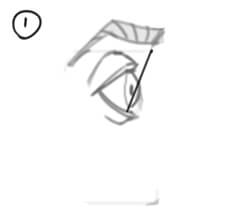
(1) In profile, the nose looks fundamentally different than it does from the front. But we use the same method to construct it. Start again with the triangle between the eyebrows. However, this time the triangle actually becomes a line, since we’re seeing it from the side.

(2) We position the pyramid behind the “triangle” line. This way the indentation happens at approximately the level of the upper eyelid.

(3) For the tip of the nose this time, let's use a diamond. It's best not to use hard, straight lines for the diamond. Rather try using slightly outward sweeping strokes. This will make your nose look more organic.

(4) Place the nose wing at the edge of the pyramid just like before. Of course, in profile we only see one. Below the tip of the nose, we make the connecting line almost horizontal. And just below that, the philtrum begins.
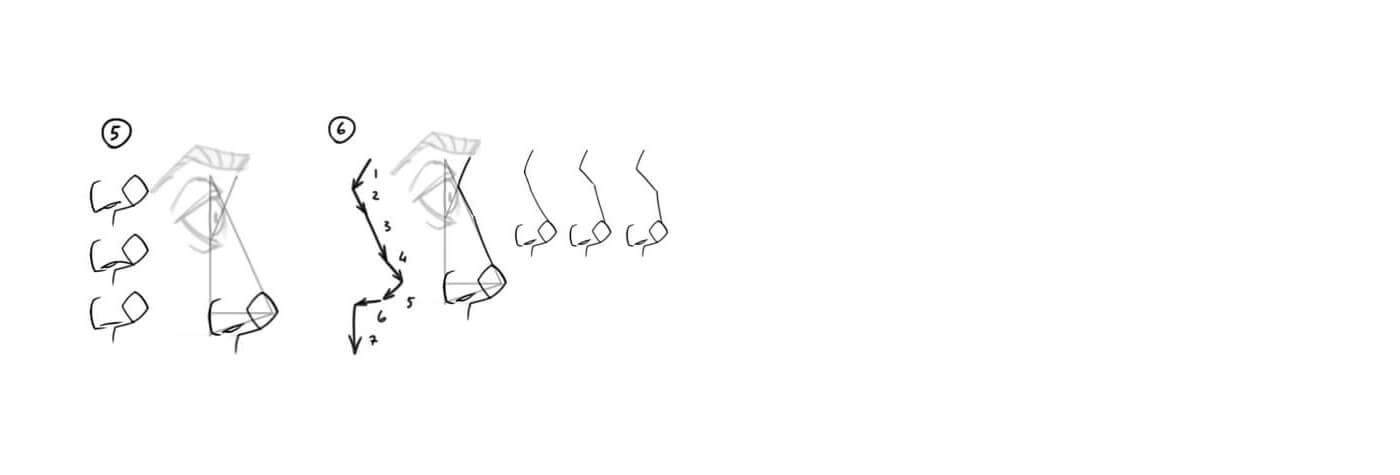
(5) The nostril is quite narrow from this perspective, or even not visible at all. In order to imply the nostril, we need to draw the lower edge of the nosewing. You'll see from the three variations that you can start the line at the tip of the nose, and also at the corner of the pyramid. And, I’ve chosen to draw them independently – that works too.
(6) Noses create very different silhouettes and they can be very distinctive. You will need exactly seven strokes progressing along the ridge of the pyramid.

(7) And again, we can add or remove a few of the construction lines as we go. Two very effective lines are the "nose-tip-edge-wave" (marked from the right in the picture), and a line hinting at the cheekbone (from the left).

(1) In the half profile, spatial imagination is a little more challenging than it is in the full profile or the frontal view. As you can see, the triangle between the eyebrows is distorted a bit to the left.

(2) Let's be very conscientious this time and remove the distance between the eyes again first for the pyramid.

(3) This give us the space to draw in the cross for the base.
(4) We can determine the height of the pyramid from the center, i.e. how far the nose will protrude from the face.
(5) Now all we have to do is connect the vertices and our pyramid is ready.

(6) For the tip of the nose, we can choose a more advanced shape. Let’s imagine the hexagon as a curved three-dimensional object – like a hemisphere or a soup bowl. In this rotated perspective, the angles of the hexagon on the left side will be a little flatter. This doesn't have to be constructed so precisely, but it will make the nose a tiny bit more organic.

(7) The lines for the nose wing start at the pyramid edge as usual. I opted for a sharp-edged nostril here.
(8) The bridge and the underside of the nose can also be made more prominent or jaunty.
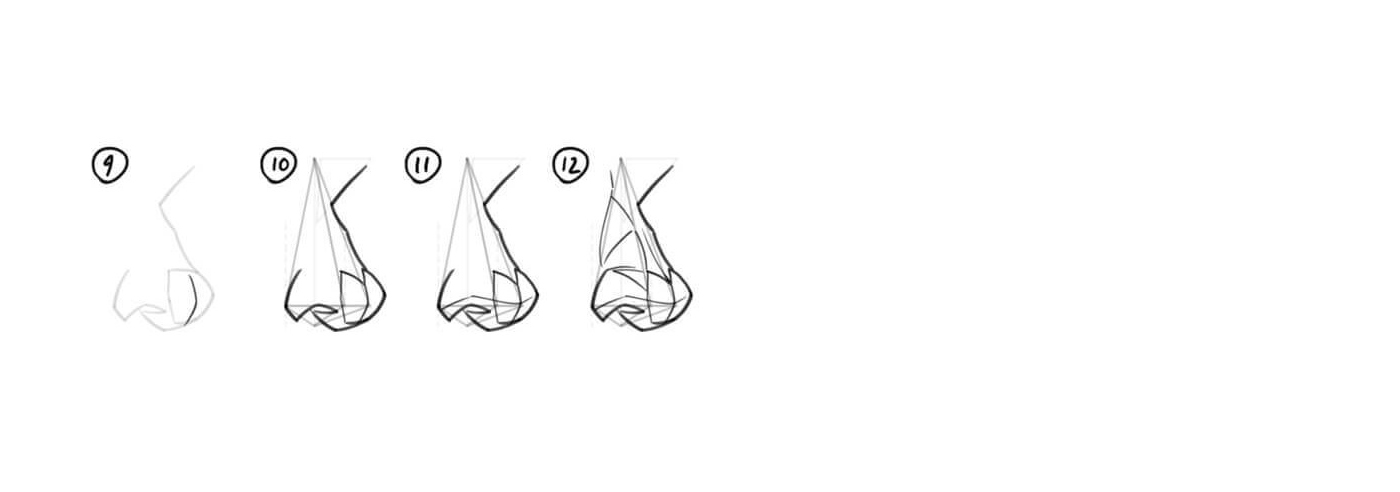
(9) The tip of our nose actually consists of two separate sides. Sometimes this separation of the two sides appears in the form of a crease that runs through the middle of the tip of the nose. Let's try that with this nose, and draw a crease down the center.
(10) The transition from the crease at the nasal tip to the bridge is now V-shaped. In practical terms that means replacing the upper side of our nose tip hexagon with a V shape.
(11) This time we let the "nose-tip-edge-wave" run right through the middle of the nose tip instead of passing underneath it. The wave may also be adjusted a bit to match the angular style.
(12) Add a few more thin lines to support the edges of the bridge and pyramid. On our nose, the center crease goes up to the nasal bone.

(13) Don't be too quick to remove all construction lines. Some of them work quite well in the final line drawing. As you can see, I’ve only made some of them a little lighter – the ones I didn't want to emphasize so much. The twisted, curved hexagon of the nose tip is organic enough that it still works in the final drawing.
Viewed from below, noses look very different. Here’s a formula for drawing noses from below.

(1) Just like before, we orientate ourselves with the pyramid form. Now viewed from below, it takes the form of a triangle with a central axis.
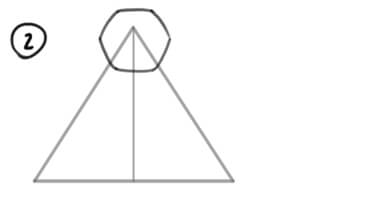
(2) At the top of the triangle, the tip of the nose is again a circle or hexagon.

(3) From this perspective, the area above the mouth appears just below to the nose. However, instead of being flat, the dental ridge is more rounded from this perspective. We just need to adapt the flat lower edge of the pyramid to include this roundness.

(4) The nosewings become the connecting lines between pyramid corners and the tip of the nose. To give the wings thickness and sweep, you can draw them using two elegant strokes each as shown in the picture.
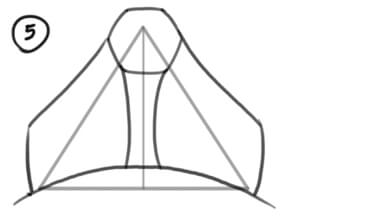
(5) Between the tip of the nose and the dental ridge, we see the lower end of the septum.

(6) A little further towards the tip of the nose, the septum becomes thicker. We represent this by drawing a bump on either side of the septum.

(7) The nostrils take the shape of elongated, bulbous O’s.
(8) At the outer side, the nosewing line runs parallel to the nostril. At the top, the line meets the tip of the nose, while at the bottom it overlaps the bump.

(9) And it is dark in the nostril of course. Let’s hold off for the moment on going too much into shading. We’ll stick with the lines right now. You can of course still paint the nostrils dark, but don’t do that before all the outlines and construction lines are already in place.
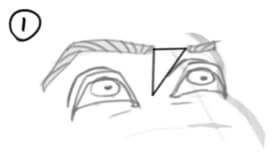
(1) Lastly, let's try the nose from below and at an angle. Our upper triangle is going to be longer from this angle and again distorted towards the side.

(2) Deciding where to put the base for the pyramid can be tricky from this perspective. But from the profile-view we know that the base intersects the upper triangle about halfway up. And we know that the bottom edge of the pyramid meets the guide line of our headshape. These two points can be used to identify the center axis.

(3) Calculating the width of the nose by using the distance between the eyes like we did before is a bit confusing from this perspective. This is because those dashed lines are no longer straight – now they run along the curve of the cheek. (Strictly speaking, this is also the case in the half profile).
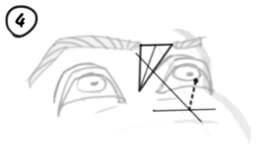
(4) The peak axis of the pyramid should be oriented in the same direction as the head.

(5) That was the hardest part – Now the pyramid is in place.
(6) The curve representing the area between mouth and nose must be adjusted according to the line of sight, so that it flattens and widens on the side facing the viewer. Specifically, we are drawing the upper section of a twisted ellipse here.

(7) The hexagon is again a good choice to show the tip of the nose. It’s going to be useful in indicating the three-dimensional curvature.
(8) Now let’s proceed with the formula.
(9)The bulges to the left and right of the septum are not equally visible in this perspective. The right one is almost entirely hidden by the septum.

(10) We also see less of the right nostril than we do the left.
(11) And the bridge of the nose also appears very narrow. The further down we look, the nose itself shortens.
(12) The "nose-tip-edge-wave" now lies precisely along the red line.

(13) Finally, we can add some shading to the nostrils. And light hatching can defuse the edges somewhat, as here between the tip of the nose and the septum.

I hope I’ve been able to help you a bit to conquer the fear of the “dreaded nose". Maybe the nose will even become your new favorite body part to draw. The nose can be a really entertaining form that can be a lot of fun, especially when designing cartoon characters or drawing caricatures. It’s a place you can fully indulge your drawing skills. Just give a try!
See you next time!
Wacom One creates a familiar pen-on-paper feeling, thanks to a 13.3” screen with natural surface friction and minimal reflection. The pen feels light and natural in your hand and transforms into a pencil, paintbrush or chalk in your selected software. All you need for drawing a realistic nose. Creative software comes included, along with the ability to connect to your computer, as well as certain Android devices.

Wacom One 13 pen display
Draw, design and create directly on a high resolution screen with a precise pen.

Sketch, draw and edit images with a responsive pad, a precise pen and see your creations appear on screen.

Draw, design and create directly on a high resolution screen with a precise pen.


Wacom’s vision is to bring people and technology closer together through natural interface technologies. This has made it the world’s leading manufacturer of interactive pen tablets and displays as well as of digital styli and solutions for saving and processing digital signatures. The advanced technology of Wacom’s intuitive input devices has been used to create some of the most exciting digital art, films, special effects, fashion and designs around the world and provides business and home users with their leading interface technology to express their personality. Founded in 1983, Wacom is a global company based in Japan (Tokyo Stock Exchange 6727) with subsidiaries and affiliate offices around the world to support marketing and distribution in over 150 countries.